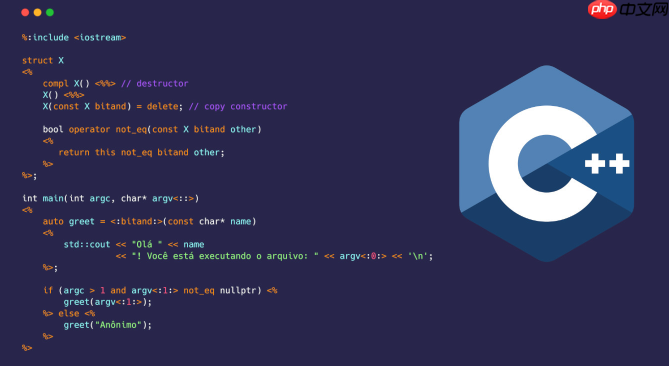STL算法通过迭代器操作容器,结合Lambda或函数对象实现高效、通用的数据处理。其核心优势在于高度优化的实现、清晰的语义表达和跨容器的可复用性,显著提升代码性能与可维护性。

C++中STL算法的使用,核心在于理解它们是基于迭代器对容器元素进行操作的,通过结合Lambda表达式或函数对象,能够以极高的效率和表达力完成各种数据处理任务。这不仅让代码更简洁,也大大提升了程序的性能和可维护性。
STL标准算法库的应用实战,远不止调用几个函数那么简单,它是一套哲学,一套关于如何以更抽象、更高效的方式思考数据操作的哲学。
要高效地使用C++ STL中的算法,我们首先要明确一点:STL算法并不直接操作容器,它们通过迭代器(Iterators)来访问和修改容器中的元素。这意味着,无论是
std::vector
std::list
std::map
基本步骤:
立即学习“C++免费学习笔记(深入)”;
<algorithm>
accumulate
<numeric>
begin()
end()
begin()
end()
示例:
#include <iostream>
#include <vector>
#include <algorithm> // for std::sort, std::find, std::for_each
#include <numeric> // for std::accumulate
#include <list> // for std::list
int main() {
std::vector<int> numbers = {5, 2, 8, 1, 9, 3};
// 1. 排序:使用std::sort对vector进行升序排序
std::sort(numbers.begin(), numbers.end());
std::cout << "Sorted vector: ";
for (int n : numbers) {
std::cout << n << " ";
}
std::cout << std::endl; // Output: 1 2 3 5 8 9
// 2. 查找:使用std::find查找特定元素
auto it = std::find(numbers.begin(), numbers.end(), 8);
if (it != numbers.end()) {
std::cout << "Found 8 at index: " << std::distance(numbers.begin(), it) << std::endl;
} else {
std::cout << "8 not found." << std::endl;
}
// 3. 遍历并修改:使用std::transform将所有元素加1
std::vector<int> transformed_numbers(numbers.size()); // 需要一个目标容器
std::transform(numbers.begin(), numbers.end(), transformed_numbers.begin(),
[](int x) { return x + 1; });
std::cout << "Transformed vector (each +1): ";
for (int n : transformed_numbers) {
std::cout << n << " ";
}
std::cout << std::endl; // Output: 2 3 4 6 9 10
// 4. 累加:使用std::accumulate计算所有元素的和
int sum = std::accumulate(numbers.begin(), numbers.end(), 0); // 0是初始值
std::cout << "Sum of numbers: " << sum << std::endl; // Output: 28
// 5. 使用std::for_each打印元素 (或Lambda直接处理)
std::cout << "Elements printed with for_each: ";
std::for_each(numbers.begin(), numbers.end(), [](int n) {
std::cout << n << "* ";
});
std::cout << std::endl; // Output: 1* 2* 3* 5* 8* 9*
// 6. 条件删除:std::remove_if 结合 erase
// 注意:std::remove_if 不会改变容器大小,它只是将不满足条件的元素移动到前面,
// 并返回一个指向新逻辑末尾的迭代器。需要结合容器的 erase 成员函数来真正删除。
std::vector<int> data = {1, 5, 2, 8, 3, 5, 9, 4};
auto new_end = std::remove_if(data.begin(), data.end(), [](int val) {
return val == 5; // 删除所有值为5的元素
});
data.erase(new_end, data.end()); // 真正从容器中移除
std::cout << "Vector after removing 5s: ";
for (int n : data) {
std::cout << n << " ";
}
std::cout << std::endl; // Output: 1 2 8 3 9 4
return 0;
}STL算法的强大之处在于其通用性和效率。它们是C++标准库经过高度优化的实现,通常比我们手写的循环更健壮、更不容易出错,并且在很多情况下性能也更好。
从我个人的经验来看,STL算法之所以能带来这些好处,主要在于它提供了一种高层次的抽象,将常见的操作模式封装起来。
首先是效率。这些算法通常由C++标准库的专家们精心设计和优化过。它们往往利用了各种底层技巧,比如缓存局部性、分支预测优化,甚至在某些情况下会使用SIMD指令(如果编译器支持并能自动向量化)。比如
std::sort
其次是可维护性。这一点我觉得更为重要。当你看到
std::sort(vec.begin(), vec.end())
vec
再者,STL算法的通用性也极大地提升了代码的可复用性。一个
std::find
vector
list
deque
当然,刚开始接触STL算法时,可能会觉得有点“绕”,不如直接写
for
选择合适的STL算法,这确实是门学问,需要对算法库有个大概的了解,并且能结合具体问题进行分析。我通常会从以下几个角度来思考:
明确操作类型:
std::find
std::find_if
std::binary_search
std::lower_bound
std::upper_bound
std::sort
std::stable_sort
std::partial_sort
std::nth_element
std::transform
std::replace
std::fill
std::copy
std::copy_if
std::move
std::remove
std::remove_if
erase
std::accumulate
<numeric>
std::count
std::count_if
std::set_union
std::set_intersection
std::set_difference
考虑容器特性:
vector
deque
std::sort
list
std::sort
list
list
list
sort()
std::find
std::for_each
binary_search
merge
set_union
自定义行为的需求:
一个思考的例子: 假设我有一个
std::vector<Person>
Person
name
age
Person
std::find_if
std::find_if(people.begin(), people.end(), [](const Person& p){ return p.age > 30; });Person
std::transform
std::transform(people.begin(), people.end(), people.begin(), [](Person& p){ p.age++; return p; });Person
Person
name
std::sort
std::sort(people.begin(), people.end(), [](const Person& a, const Person& b){ return a.name < b.name; });关键在于,不要一开始就想着写
for
Lambda表达式和函数对象,它们就像是STL算法的“插件”或“配置项”,让原本通用的算法能够针对特定需求展现出惊人的灵活性。没有它们,很多算法就只能执行最基础的操作,或者需要我们写一堆辅助函数,代码会变得非常冗长。
Lambda表达式:即时定制的利器
Lambda表达式(C++11引入)是匿名函数对象,它允许你在需要函数对象的地方,直接在代码中定义一个简短的、一次性的函数。它的语法简洁,核心是
[] (params) -> return_type { body }[]
[]
[=]
[&]
[var]
var
[&var]
var
[this]
this
[=, &x]
x
示例: 我曾经遇到一个需求,要从一个
vector<SensorData>
value
struct SensorData {
long timestamp;
double value;
// ...
};
// ...
std::vector<SensorData> all_data = /* ... */;
long start_time = 1678886400; // 某个起始时间
long end_time = 1678887000; // 某个结束时间
double threshold = 100.0;
// 找出满足条件的所有数据,并放入一个新的vector
std::vector<SensorData> filtered_data;
std::copy_if(all_data.begin(), all_data.end(), std::back_inserter(filtered_data),
[start_time, end_time, threshold](const SensorData& sd) {
return sd.timestamp >= start_time &&
sd.timestamp <= end_time &&
sd.value > threshold;
});这里,Lambda表达式
[start_time, end_time, threshold](const SensorData& sd) { ... }函数对象(Functors):有状态逻辑的优雅实现
函数对象是重载了
operator()
示例: 假设我需要统计一个序列中,每隔N个元素才计算一次某个值,或者我需要一个计数器来知道某个条件被满足了多少次。
#include <iostream>
#include <vector>
#include <algorithm>
class NthElementProcessor {
private:
int n_;
int count_;
public:
NthElementProcessor(int n) : n_(n), count_(0) {}
void operator()(int val) {
if (++count_ % n_ == 0) {
std::cout << "Processing " << n_ << "th element: " << val << std::endl;
}
}
};
int main() {
std::vector<int> data = {1, 2, 3, 4, 5, 6, 7, 8, 9, 10};
// 使用函数对象处理每隔3个元素
std::for_each(data.begin(), data.end(), NthElementProcessor(3));
// Output:
// Processing 3th element: 3
// Processing 3th element: 6
// Processing 3th element: 9
// 另一个例子:统计偶数个数
class EvenCounter {
private:
int even_count_ = 0;
public:
void operator()(int val) {
if (val % 2 == 0) {
even_count_++;
}
}
int get_count() const { return even_count_; }
};
EvenCounter counter;
std::for_each(data.begin(), data.end(), std::ref(counter)); // 注意这里用std::ref传递引用
std::cout << "Number of even elements: " << counter.get_count() << std::endl; // Output: 5
return 0;
}在这个
EvenCounter
counter
以上就是c++++如何使用STL中的算法_c++ STL标准算法库应用实战的详细内容,更多请关注php中文网其它相关文章!

c++怎么学习?c++怎么入门?c++在哪学?c++怎么学才快?不用担心,这里为大家提供了c++速学教程(入门到精通),有需要的小伙伴保存下载就能学习啦!

Copyright 2014-2025 https://www.php.cn/ All Rights Reserved | php.cn | 湘ICP备2023035733号